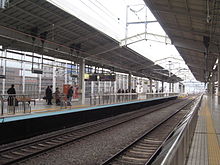Kyoto station
| Kyoto station | |
|---|---|
|
Station building
|
|
| Data | |
| Location in the network | Junction station |
| Platform tracks | 18 (JR) 4 (Kintetsu) 2 (Kyoto Subway) |
| abbreviation | キ ト ( KI-TO ) |
| opening | February 6, 1877 (JR) November 15, 1928 (Kintetsu) May 29, 1981 (Kyoto Subway) |
| location | |
| City / municipality | Kyoto |
| prefecture | Kyoto |
| Country | Japan |
| Coordinates | 34 ° 59 '8 " N , 135 ° 45' 28" E |
| Railway lines | |
| List of train stations in Japan | |
The Kyōto Station ( Japanese 京都 駅 , Kyōto-eki ) is a large train station in the Japanese city of Kyōto .
Transport links
The station is connected to the Tōkaidō Shinkansen , various JR West lines , the private Kintetsu Kyōto Line and the Kyoto subway . There is a bus station in front of the station building.
With over 200,000 passengers per day on the JR West, Kyoto was the station with the second highest number of passengers in the JR West network after Osaka in 2016. In the same year, the subway station was used by over 120,000 passengers every day.
history
In September 1876 Kyoto was connected to a line of the Japanese Ministry of Railways . Since the station was not yet completed at that time, a makeshift station "Ōmiya-dōri" was used first. The first Kyoto station was opened on February 5, 1877 by a decree of Emperor Meiji .
In 1889 the railway became part of the Tōkaidō main line , the station then became the terminus of two private railways that connected it to the northern and southern parts of Kyoto Prefecture: the Nara Railway in 1895 (today's Nara Line) and in 1897 the Kyoto Railway (today's Sagano line).
The station was replaced by a new Renaissance-style building in 1914. The station square, which was on the site of the demolished original station, was often used by imperial car columns before and during the Second World War when Emperor Hirohito was en route between Kyoto and Tokyo. The station burned down in 1950 and was replaced by a more functional concrete building in 1952.
A new train station was inaugurated in 1997 for the city's 1200th anniversary. The building designed by Hiroshi Hara is 70 meters high, 470 meters long and has a floor area of 237,689 square meters. Architecturally, it takes up elements of futurism , such as the slightly irregular glass facade on a steel frame.
The construction of the station building was highly controversial and was accompanied by protests by trade unions and interest groups.
In addition to the station facilities, the building houses a hotel, shopping center, restaurants, snack bars and other shops and services for travelers; on the roof is a viewing terrace.
Lines
Kyōto is served by the following lines:
- JR Central Tōkaidō Shinkansen
- JR West Tōkaidō Main Line
- JR West San'in Main Line
- JR West Kosei Line
- JR West Nara Line
- Kintetsu Kyōto Line
- Kyoto Subway Karasuma Line
|
←
|
Lines |
→
|
||
|---|---|---|---|---|
| Maibara |
JR Tōkai |
Shin-Osaka | ||
| Yamashina |
JR West |
Nishiōji | ||
| Beginning |
JR West |
Tambaguchi | ||
| Beginning |
JR West |
Tofukuji | ||
Web links
Individual evidence
- ↑ yes: デ ー タ で 見 る JR 西 日本. JR West seen through dates. West Japan Railway Company, 2017. Retrieved December 18, 2017 (Japanese).
- ↑ yes: 産業 交通 水道 委員会 資料 陳 情 第 81 号. Kyoto City Assembly, October 25, 2017, accessed December 18, 2017 (Japanese).
- ↑ Ishino, Tetsu et al. (Ed.): 停車場 変 遷 大事 典 国 鉄 ・ JR 編 . Station change directory - JNR / JR. tape II . JTB Corporation, Tokyo 1998, ISBN 4-533-02980-9 , pp. 34 (Japanese).
- ↑ Ishino, Tetsu et al. (Ed.): 停車場 変 遷 大事 典 国 鉄 ・ JR 編 . Station change directory - JNR / JR. tape II . JTB Corporation, Tokyo 1998, ISBN 4-533-02980-9 , pp. 298,351 (Japanese).
- ↑ Christoph Brumann: Machiya vs. Manshon: Notes from the urban war in Kyoto. Retrieved February 20, 2019 .


